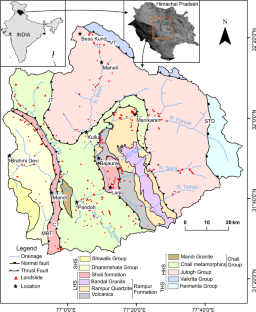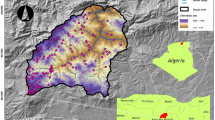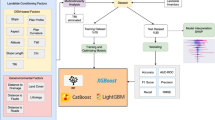Abstract
Landslide is one of the most destructive hazards in the Upper Beas valley of the Himalayan region of India. Landslide susceptibility mapping is an important and preliminary task in order to prospect the spatial variability of landslide prone zones in the area. As the use of machine learning algorithms has increased the success rate in susceptibility studies, the performance of the four machine learning models, namely Naïve Bayes (NB), K-Nearest Neighbor (KNN), Random Forest (RF) and Extreme Gradient Boosting (XGBoost) were initially tested for landslide susceptibility mapping in the area. Landslide inventory containing both landslide and non-landslide data and thirteen landslide conditioning factors were considered to train the models. The models were optimized using hyperparameter optimization and input factors selection based on variable importance. Among the four models, Extreme Gradient Boosting (XGBoost), an advanced ensemble-based machine learning algorithm, demonstrated superior performance (AUC = ~ 0.91) followed by RF, NB and KNN with AUC values of ~ 0.88, ~ 0.87, and ~ 0.82. Therefore, XGboost model was selected for detailed study, including sensitivity analysis. The results depict that 44% of the total area falls under high and very high susceptible zones. Southward facing slopes having inclination between 31˚-50˚ located at an elevation of 2001–3000 m in the vicinity of road and drainage network contain most of the landslide susceptible zones. Sensitivity analysis has provided an in-depth understanding of the factors’ relation with the model as the XGBoost model is most sensitive to factors such as slope inclination, distance to thrust and road, elevation, TWI and slope aspect.













Similar content being viewed by others
Data availability
All data included in this study are available upon request by contact with the corresponding author.
References
Achour Y, Pourghasemi HR (2020) How do machine learning techniques help in increasing accuracy of landslide susceptibility maps? Geosci Front 11(3):871–883
Achour Y, Saidani Z, Touati R, Pham QB, Pal SC, Mustafa F, Balik Sanli F (2021) Assessing landslide susceptibility using a machine learning-based approach to achieving land degradation neutrality. Environ Earth Sci 80:1–20
Akgun A (2012) A comparison of landslide susceptibility maps produced by logistic regression, multi-criteria decision, and likelihood ratio methods: a case study at İzmir, Turkey. Landslides 9(1):93–106
Aktas H, San BT (2019) Landslide susceptibility mapping using an automatic sampling algorithm based on two level random sampling. Comput Geosci 133:104329
Alcántara-Ayala I (2002) Geomorphology, natural hazards, vulnerability and prevention of natural disasters in developing countries. Geomorphology 47(2–4):107–124
Ali SA, Parvin F, Vojteková J, Costache R, Linh NT, Pham QB, Vojtek M, Gigović L, Ahmad A, Ghorbani MA (2021) GIS-based landslide susceptibility modeling: a comparison between fuzzy multi-criteria and machine learning algorithms. Geosci Front 12(2):857–876
Althuwaynee OF, Pradhan B, Park HJ, Lee JH (2014) A novel ensemble decision tree-based CHi-squared Automatic Interaction Detection (CHAID) and multivariate logistic regression models in landslide susceptibility mapping. Landslides 11:1063–1078
Ambraseys N, Bilham R (2000) A note on the Kangra M s = 7.8 earthquake of 4 April 1905. Curr Sci 79(1):45–50
Arabameri A, Cerda A, Pradhan B, Tiefenbacher JP, Lombardo L, Bui DT (2000) (2020) A methodological comparison of head-cut based gully erosion susceptibility models: Combined use of statistical and artificial intelligence. Geomorphology 359:107–136
Bizimana H, Sönmez O (2015) Landslide occurrences in the hilly areas of Rwanda, their causes and protection measures. Disaster Sci Eng 1(1):1–7
Breiman L (2001) Random forests. Mach Learn 45(1):5–32
Breiman L (2002) Manual on setting up, using, and understanding Random Forests V3.1. https://www.stat.berkeley.edu/~breiman/Using_random_forests_V3.1.pdf. Accessed 11 Jan 2022
Budetta P (2004) Assessment of rockfall risk along roads. Nat Hazards Earth Syst Sci 4(1):71–81
Can R, Kocaman S, Gokceoglu C (2021) A comprehensive assessment of XGBoost algorithm for landslide susceptibility mapping in the upper basin of Ataturk dam, Turkey. Appl Sci 11(11):4993
Chahal P, Rana N, Bisht P, Bagri DS, Wasson RJ, Sundriyal Y (2017) Identification of landslide-prone zones in the geomorphically and climatically sensitive Mandakini valley, (central Himalaya), for disaster governance using the weights of evidence method. Geomorphology 284:41–52
Chen T, He T, Benesty M, Khotilovich V, Tang Y, Cho H, Chen K, Mitchell R, Cano I, Zhou T (2015) Xgboost: extreme gradient boosting. R package version 0.4-2 1(4):1–4
Chen XL, Liu CG, Chang ZF, Zhou Q (2016) The relationship between the slope angle and the landslide size derived from limit equilibrium simulations. Geomorphology 253:547–550
Chen W, Xie X, Wang J, Pradhan B, Hong H, Bui DT, Duan Z, Ma J (2017) A comparative study of logistic model tree, random forest, and classification and regression tree models for spatial prediction of landslide susceptibility. Catena 151:147–160
Chowdhuri I, Pal SC, Chakrabortty R, Malik S, Das B, Roy P, Sen K (2021) Spatial prediction of landslide susceptibility using projected storm rainfall and land use in himalayan region. Bull Eng Geol Environ 80:5237–5258
Clarke BA, Burbank DW (2010) Bedrock fracturing, threshold hillslopes, and limits to the magnitude of bedrock landslides. Earth Planet Sci Lett 297(3–4):577–586
Cover T, Hart P (1967) Nearest neighbor pattern classification. IEEE Trans Inf Theory 13(1):21–27
Das G, Lepcha K (2019) Application of logistic regression (LR) and frequency ratio (FR) models for landslide susceptibility mapping in Relli Khola river basin of Darjeeling Himalaya, India. SN Appl Sci 1(11):1–22
Devkota KC, Regmi AD, Pourghasemi HR, Yoshida K, Pradhan B, Ryu IC, Dhital MR, Althuwaynee OF (2013) Landslide susceptibility mapping using certainty factor, index of entropy and logistic regression models in GIS and their comparison at Mugling–Narayanghat road section in Nepal Himalaya. Nat Hazards 65:135–165
Dhiman RK, Thakur M (2021) Rockfall Hazard Assessment using RAMMS for the SE facing escarpment of Manikaran, Himachal Pradesh, India. In: Rai PK, Singh P, Mishra VN (eds) Recent Technologies for Disaster Management and Risk Reduction. Earth and Environmental Sciences Library. Springer, Cham, pp 57–74
Di Napoli M, Carotenuto F, Cevasco A, Confuorto P, Di Martire D, Firpo M, Pepe G, Raso E, Calcaterra D (2020) Machine learning ensemble modelling as a tool to improve landslide susceptibility mapping reliability. Landslides 17(8):1897–1914
Drid I, Achour Y, Zighmi K, Nouioua T, Khababa O, Rahmani S, Ouadfel O, Atoui B (2022) Designing gully erosion susceptibility maps (GESM) in the Algerian Eastern tell: a case study of the K’sob River watershed. Arab J Geosci 15(14):1264
Feizizadeh B, Jankowski P, Blaschke T (2014) A GIS based spatially-explicit sensitivity and uncertainty analysis approach for multi-criteria decision analysis. Comput Geosci 64:81–95
Gokceoglu C, Sezer E (2009) A statistical assessment on international landslide literature (1945–2008). Landslides 6:345–351
Guha-Sapir D, Below R, Hoyois P (2020) EM-DAT: the CRED/OFDA international disaster database. Centre for Research on the Epidemiology of Disasters (CRED), Université Catholique de Louvain, Brussels
Gupta V, Sah MP, Virdi NS, Bartarya SK (1993) Landslide hazard zonation in the upper Satluj valley, District Kinnaur, Himachal Pradesh. J Himal Geol 4(1):81–93
Gupta V, Bhasin RK, Kaynia AM, Tandon RS, Venkateshwarlu B (2016) Landslide hazard in the Nainital township, Kumaun Himalaya, India: the case of September 2014 Balia Nala landslide. Nat Hazards 80:863–877
Gupta V, Paul A, Kumar S, Dash B (2021) Spatial distribution of landslides vis-à-vis epicentral distribution of earthquakes in the vicinity of the Main Central Thrust Zone, Uttarakhand Himalaya. India Curr Sci 120(12):1927–1932
Gupta V, Kumar S, Kaur R, Tandon RS (2022) Regional-scale landslide susceptibility assessment for the hilly state of Uttarakhand, NW Himalaya, India. J Earth Syst Sci 131(1):2
He K, Ma G, Hu X, Luo G, Mei X, Liu B, He X (2019) Characteristics and mechanisms of coupled road and rainfall-induced landslide in Sichuan China. Geomatics, Nat Hazards Risk 10(1):2313–2329
https://bhukosh.gsi.gov.in/ (n.d.) Accessed 13 May 2020
https://chrsdata.eng.uci.edu/ (n.d.) Accessed 11 June 2020
Huang Y, Zhao L (2018) Review on landslide susceptibility mapping using support vector machines. Catena 165:520–529
Huang F, Cao Z, Guo J, Jiang SH, Li S, Guo Z (2020) Comparisons of heuristic, general statistical and machine learning models for landslide susceptibility prediction and mapping. Catena 191:104580
Ilia I, Tsangaratos P (2016) Applying weight of evidence method and sensitivity analysis to produce a landslide susceptibility map. Landslides 13(2):379–397
Jennifer JJ, Saravanan S (2022) Artificial neural network and sensitivity analysis in the landslide susceptibility mapping of Idukki district, India. Geocarto Int 37(19):5693–5715
Johnson D (2019) R Random Forest tutorial with example. GURU99. https://www.guru99.com/r-random-forest-tutorial.html. Accessed 11 Jan 2022
Karakas G, Can R, Kocaman S, Nefeslioglu HA, Gokceoglu C (2020) Landslide susceptibility mapping with random forest model for Ordu, Turkey. ISPRS - Int Arch Photogram Remote Sens Spat Info Sci XLIII-B3-2020:1229–1236
Keesstra SD, Bouma J, Wallinga J, Tittonell P, Smith P, Cerdà A, Montanarella L, Quinton JN, Pachepsky Y, Van Der Putten WH, Bardgett RD (2016) The significance of soils and soil science towards realization of the United Nations Sustainable Development Goals. Soil 2(2):111–128
Khanna R, Dubey RK (2021) Comparative assessment of slope stability along road-cuts through rock slope classification systems in Kullu Himalayas, Himachal Pradesh, India. Bull Eng Geol Environ 80:993–1017
Kumar R, Anbalagan R (2016) Landslide susceptibility mapping using analytical hierarchy process (AHP) in Tehri reservoir rim region, Uttarakhand. J Geol Soc India 87:271–286
Kumar S, Gupta V (2021) Evaluation of spatial probability of landslides using bivariate and multivariate approaches in the Goriganga valley, Kumaun Himalaya, India. Nat Hazards 109:2461–2488
Kumar A, Sharma RK, Bansal VK (2018) Landslide hazard zonation using analytical hierarchy process along National Highway-3 in mid Himalayas of Himachal Pradesh, India. Environ Earth Sci 77:1–19
Local (2023) LOCAL Situation Report – 012/2023 (16/08/2023). Local organisations’ coalition for advancing localisation. https://reliefweb.int/report/india/local-situation-report-0122023-16082023. Accessed 15 Sept 2023
Manzo G, Tofani V, Segoni S, Battistini A, Catani F (2013) GIS techniques for regional-scale landslide susceptibility assessment: the Sicily (Italy) case study. Int J Geogr Inf Sci 27(7):1433–1452
Meena SR, Mishra BK, Tavakkoli Piralilou S (2019) A hybrid spatial multi-criteria evaluation method for mapping landslide susceptible areas in kullu valley, himalayas. Geosciences 9(4):156
Mehta BS, Parti RA, Sharma RK (2010) Landslide hazard analysis and zonation on National Highway-21 from Panasra to Manali, HP, India. Int J Earth Sci Eng 3(3):376–381
Merghadi A, Yunus AP, Dou J, Whiteley J, ThaiPham B, Bui DT, Avtar R, Abderrahmane B (2020) Machine learning methods for landslide susceptibility studies: a comparative overview of algorithm performance. Earth-Sci Rev 207:103225
Micheletti N, Foresti L, Robert S, Leuenberger M, Pedrazzini A, Jaboyedoff M, Kanevski M (2014) Machine learning feature selection methods for landslide susceptibility mapping. Math Geosci 46(1):33–57
Misra DK, Tewari VC (1988) Tectonics and sedimentation of the rocks between Mandi and Rohtang, Beas valley, Himachal Pradesh, India. Geosci J 9(2):53–172
Neaupane KM, Piantanakulchai M (2006) Analytic network process model for landslide hazard zonation. Eng Geo 85(3–4):281–294
Nseka D, Kakembo V, Bamutaze Y, Mugagga F (2019) Analysis of topographic parameters underpinning landslide occurrence in Kigezi highlands of southwestern Uganda. Nat Hazards 99(2):973–989
Peterson LE (2009) K-nearest neighbor. Scholarpedia 4(2):1883
Petley D (2012) Global patterns of loss of life from landslides. Geology 40(10):927–930
Pham BT, Jaafari A, Prakash I, Bui DT (2019) A novel hybrid intelligent model of support vector machines and the MultiBoost ensemble for landslide susceptibility modeling. Bull Eng Geol Environ 78(4):2865–2886
Pham QB, Achour Y, Ali SA, Parvin F, Vojtek M, Vojteková J, Al-Ansari N, Achu AL, Costache R, Khedher KM, Anh DT (2021) A comparison among fuzzy multi-criteria decision making, bivariate, multivariate and machine learning models in landslide susceptibility mapping. Geomatics, Nat Hazards Risk 12(1):1741–1777
Postance B, Hillier J, Dijkstra T, Dixon N (2017) Extending natural hazard impacts: an assessment of landslide disruptions on a national road transportation network. Environ Res Lett 12(1):014010
Poudyal CP, Chang C, Oh HJ, Lee S (2010) Landslide susceptibility maps comparing frequency ratio and artificial neural networks: a case study from the Nepal Himalaya. Environ Earth Sci 61(5):1049–1064
Pourghasemi HR, Teimoori Yansari Z, Panagos P, Pradhan B (2018) Analysis and evaluation of landslide susceptibility: a review on articles published during 2005–2016 (periods of 2005–2012 and 2013–2016). Arab J Geosci 11(9):1–12
Pradhan AM, Kim YT (2014) Relative effect method of landslide susceptibility zonation in weathered granite soil: a case study in Deokjeok-Ri Creek, South Korea. Nat Hazards 72(2):1189–1217
Pradhan SP, Panda SD, Roul AR, Thakur M (2019) Insights into the recent Kotropi landslide of August 2017, India: a geological investigation and slope stability analysis. Landslides 16(8):1529–1537
Prasad AS, Pandey BW, Leimgruber W, Kunwar RM (2016) Mountain hazard susceptibility and livelihood security in the upper catchment area of the river Beas, Kullu Valley, Himachal Pradesh, India. Geoenvironmental Disasters 3(1):1–7
Rabby YW, Hossain MB, Abedin J (2020) Landslide susceptibility mapping in three Upazilas of Rangamati hill district Bangladesh: application and comparison of GIS-based machine learning methods. Geocarto Int 37(12):3371–3396
Ram P, Gupta V, Devi M, Vishwakarma N (2020) Landslide susceptibility mapping using bivariate statistical method for the hilly township of Mussoorie and its surrounding areas, Uttarakhand Himalaya. J Earth Syst Sci 129(1):1–18
Sabokbar HF, Roodposhti MS, Tazik E (2014) Landslide susceptibility mapping using geographically-weighted principal component analysis. Geomorphology 226:15–24
Sah MP, Mazari RK (1998) Anthropogenically accelerated mass movement, Kulu Valley, Himachal Pradesh, India. Geomorphology 26(1–3):123–138
Sah MP, Mazari RK (2007) An overview of the geoenvironmental status of the Kullu Valley, Himachal Pradesh, India. J Mt Sci 4(1):003–023
Sahin EK (2020) Assessing the predictive capability of ensemble tree methods for landslide susceptibility mapping using XGBoost, gradient boosting machine, and random forest. SN Appl Sci 2(7):1–17
Saraswat M (2020) Beginners Tutorial on XGBoost and Parameter Tuning in R. hackerearth. https://www.hackerearth.com/practice/machine-learning/machine-learning-algorithms/beginners-tutorial-on-xgboost-parameter-tuning-r/tutorial/. Accessed 11 Jan 2022
Scheingross JS, Minchew BM, Mackey BH, Simons M, Lamb MP, Hensley S (2013) Fault-Zone controls on the spatial distribution of slow-moving landslides. Geol Soc Am Bull 125(3–4):473–489
Shahabi H, Shirzadi A, Ghaderi K, Omidvar E, Al-Ansari N, Clague JJ, Geertsema M, Khosravi K, Amini A, Bahrami S, Rahmati O (2020) Flood detection and susceptibility mapping using sentinel-1 remote sensing data and a machine learning approach: hybrid intelligence of bagging ensemble based on k-nearest neighbor classifier. Remote Sens 12(2):266
Solanki A, Gupta V, Joshi M (2022) Application of machine learning algorithms in landslide susceptibility mapping, Kali Valley, Kumaun Himalaya, India. Geocarto Int 1–26. https://doi.org/10.1080/10106049.2022.2120546
Srivastava T (2020) How to use XGBoost algorithm in R in easy steps. Analytics Vidhya. https://www.analyticsvidhya.com/blog/2016/01/xgboost-algorithm-easy-steps/. Accessed 11 Jan 2022
Stead D, Wolter A (2015) A critical review of rock slope failure mechanisms: the importance of structural geology. J Struct Geol 74:1–23
Tien Bui D, Ho TC, Pradhan B, Pham BT, Nhu VH, Revhaug I (2016) GIS-based modeling of rainfall-induced landslides using data mining-based functional trees classifier with AdaBoost, Bagging, and MultiBoost ensemble frameworks. Environ Earth Sci 75(14):1101
Tiwari A, Sain K, Kumar A, Tiwari J, Paul A, Kumar N, Haldar C, Kumar S, Pandey CP (2022) Potential seismic precursors and surficial dynamics of a deadly himalayan disaster: an early warning approach. Sci Rep 12(1):1–13
Van Westen CJ, Rengers N, Soeters R (2003) Use of geomorphological information in indirect landslide susceptibility assessment. Nat Hazards 30(3):399–419
Varnes DJ (1978) Slope movements, type and processes. In: Schuster RL, Krizek RJ (eds) Landslide analysis and control, Transportation Research Board. National Academy Sciences, Washington, DC, pp 11–33 (Special report 176)
Versain LD, Banshtu RS, Pandey DD (2019) Comparative evaluation of GIS based landslide hazard zonation maps using different approaches. J Geol Soc India 93(6):684–692
Vijay R, Kushwaha VK, Chaudhury AS, Naik K, Gupta I, Kumar R, Wate SR (2016) Assessment of tourism impact on land use/land cover and natural slope in Manali, India: a geospatial analysis. Environ Earth Sci 75(1):1–9
Webb GI, Keogh E, Miikkulainen R (2010) Naïve Bayes. Encycl Mach Learn 15:713–714
Wu X, Ren F, Niu R (2014) Landslide susceptibility assessment using object mapping units, decision tree, and support vector machine models in the Three Gorges of China. Environ Earth Sci 71(11):4725–4738
Wu Y, Ke Y, Chen Z, Liang S, Zhao H, Hong H (2020) Application of alternating decision tree with AdaBoost and bagging ensembles for landslide susceptibility mapping. Catena 187:104396
Youssef AM, Pourghasemi HR (2021) Landslide susceptibility mapping using machine learning algorithms and comparison of their performance at Abha Basin, Asir Region, Saudi Arabia. Geosci Front 12(2):639–655
Yu X, Zhang K, Song Y, Jiang W, Zhou J (2021) Study on landslide susceptibility mapping based on rock–soil characteristic factors. Sci Rep 11(1):1–27
Zhao P, Masoumi Z, Kalantari M, Aflaki M, Mansourian A (2022) A GIS-Based landslide susceptibility mapping and variable importance analysis using Artificial Intelligent Training-based methods. Remote Sens 14(1):211
Acknowledgements
The authors thank the Director, Wadia Institute of Himalayan Geology, Dehradun for his constant encouragement and providing necessary facilities to carry out the work. RK acknowledges the financial assistance in the form of fellowship from Council of Scientific and Industrial Research (CSIR), New Delhi. Dr. Bikash Ram and Ambar Solanki are also thanked for their precious assistance in writing the article. The article bears the Wadia Institute contribution number WIHG/0248.
Author information
Authors and Affiliations
Corresponding author
Ethics declarations
Competing interest
The authors declare that they have no known competing financial interests or personal relationships that could have appeared to influence the work reported in this paper.
Additional information
Publisher’s Note
Springer Nature remains neutral with regard to jurisdictional claims in published maps and institutional affiliations.
Rights and permissions
About this article
Cite this article
Kaur, R., Gupta, V. & Chaudhary, B.S. Landslide susceptibility mapping and sensitivity analysis using various machine learning models: a case study of Beas valley, Indian Himalaya. Bull Eng Geol Environ 83, 228 (2024). https://doi.org/10.1007/s10064-024-03712-y
Received:
Accepted:
Published:
DOI: https://doi.org/10.1007/s10064-024-03712-y




